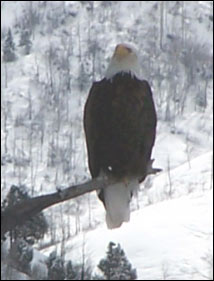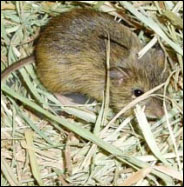















Successes in Stewardship: April 2006 |
|---|

|
Federal Highway Administration
April 2006
Wyoming Takes a Programmatic Approach to Biological Assessment

Certain highway projects can adversely affect local wildlife habitat. Project impacts may include direct effects from land use changes, habitat loss, and construction disturbances such as noise and air pollution. Indirect and cumulative effects also can influence local species and habitats after the project has been completed.
Accordingly, Section 7 of the Endangered Species Act (ESA) requires an action agency (the agency leading a project) to ensure that any activities it authorizes, funds, or implements are not likely to jeopardize the continued existence of any endangered or threatened species or result in the destruction or adverse modification of critical habitat. The action agency must consult with the US Fish and Wildlife Service (USFWS) for concurrence or recommendations. Typically, this Section 7 consultation is done at the project level — that is, for each project the action agency must conduct a Biological Assessment and submit it to USFWS for its corresponding Biological Opinion. However, this project-by-project approach may result in inefficient use of agency resources and lengthy project schedules.
Moving beyond the project-by-project approach, the Wyoming Department of Transportation (WYDOT) has taken a programmatic approach to species protection and project streamlining that precludes project-level Section 7 consultation for projects in its five year State Transportation Improvement Program (STIP). This month's newsletter describes how WYDOT and its partner agencies worked together to develop a Programmatic Agreement with USFWS that satisfies regulatory requirements, conserves endangered and threatened species and their habitats, allows more efficient use of agency resources, and strengthens interagency relationships.
In 2003, WYDOT teamed up with the Federal Highway Administration (FHWA) Wyoming Division and the USFWS to initiate a joint agency initiative that would result in a Programmatic Biological Assessment (PBA) for all Wyoming-listed threatened and endangered species and critical habitats, as well as a Programmatic Biological Opinion (PBO). The PBA was submitted to USFWS in March 2005; the Service then issued its PBO in November 2005.
The PBA/PBO streamlines the Section 7 process for all projects planned within the five-year STIP. None of these projects will require a separate consultation under Section 7, except for the following reasons:
The PBA/PBO also allows WYDOT to substitute similar projects in similar locations, without further consultation with the USFWS. For example, WYDOT can substitute a new project for a project on the STIP without additional environmental evaluations, as long as the effects of the new project are determined to be the same or less than the STIP project.
Upcoming Newsletter Topics: Tell Us What You Think
FHWA has several new and interesting newsletter topics in store for readers this spring and summer. If you have any ideas for topics to explore or revisit, or have any other questions or comments about the Success in Stewardship newsletter, please submit feedback at http://environment.fhwa.dot.gov/feedback.asp. Upcoming newsletter topics include:
The PBA evaluated the effects of the WYDOT 2005-2009 STIP projects on Wyoming's endangered, threatened, proposed, and experimental non-essential species listed under the ESA. WYDOT collaborated with specialists in both the private and public sector. A group of representatives from USFWS, FHWA, WYDOT, and an environmental consultant met monthly to write the PBA, which documented project location, type of improvement, project category, species determination, project impacts on species and critical habitat, and effect determinations. Conservation measures were identified to minimize project impacts for those species likely to be adversely affected. In 2009, the effect of these projects on threatened and endangered species will be re-evaluated and a new PBA will be developed.
The USFWS PBO is based on an environmental baseline for the action area, the PBA impacts and effects statement, and a cumulative effects assessment. The PBO determined that the effects of the WYDOT STIP are not likely to jeopardize the continued existence of listed species and will not affect critical habitat. However, it did determine the need for an Incidental Take Statement for two listed species, the bald eagle and the Preble's meadow jumping mouse. Reasonable and Prudent Measures were determined necessary to minimize take on those two species. The three agencies cooperated on the terms and conditions of implementing these measures and will meet annually to review the effectiveness of both the conservation measures identified in the PBA and the terms and conditions set forth in the PBO.
Currently there are four endangered species and eight threatened species inhabiting or potentially inhabiting parts of Wyoming. As noted above, it was determined that WYDOT highway projects could have adverse effects on the habitat of two of these species, the Preble's meadow jumping mouse and the bald eagle. The Programmatic Agreement set out conservation measures to minimize take of these species and they are discussed below.

Conservation measures for the Preble's Meadow Jumping Mouse includes reclaiming disturbed vegetated areas in the mouse's habitat. (Photo courtesy of WYDOT.) |
The Preble's meadow jumping mouse has been listed as a threatened species since May 1998. The primary habitat of the Preble's mouse occurs in dense undergrowth consisting of grasses, shrubs, and trees primarily along perennial stream areas, and can be found in southeast portions of Wyoming. The decline in numbers of the Preble's mouse can be attributed to a variety of factors, including habitat loss, degradation, and fragmentation, as well as herbicide and pesticide use.
Wyoming established the following conservation measures in the Programmatic Agreement:
The bald eagle is listed as a threatened species throughout most of the United States. In Wyoming, most bald eagles can be found in the northwest portion of the State, and along the rivers. However, because the bald eagle is highly mobile, it can be found throughout the State; it may fly long distances to feed or nest in places that are not typically listed as important or critical habitats for the species. Highway construction projects could affect habitat loss, which could lead to disturbed breeding or winter nesting areas.
Wyoming established the following conservation efforts in the PBA:
Wyoming's collaborative approach enabled WYDOT, FHWA, and USFWS to reach an agreement on how to conserve endangered and threatened species and their habitats and to streamline Section 7 environmental assessments for the next five years. All partner agencies benefit from this programmatic evaluation of STIP projects, saving time and resources that would have been spent on individual assessments. Additionally, the process helped the agencies form stronger relationships, building a foundation for successful collaborations in the future.
Rod Vaughn
FHWA Wyoming Division
2617 East Lincolnway, Suite D
Cheyenne, WY 82009
307-772-2004 ext.148
rodney.vaughn@fhwa.dot.gov
Jodi Bush
US FWS Wyoming
5353 Yellowstone Road
Cheyenne, WY 82003
307.772.2374 ext.31
Jodi_Bush@fws.gov
Tom Hart
Wyoming DOT
5300 Bishop Blvd
Cheyenne, WY 82009
307-777-4495
Thomas.Hart@dot.state.wy.us
"Successes in Stewardship" is a Federal Highway Administration newsletter highlighting current environmental streamlining and stewardship practices from around the country. To subscribe, visit the Registration Site, or call 617-494-3137. |
